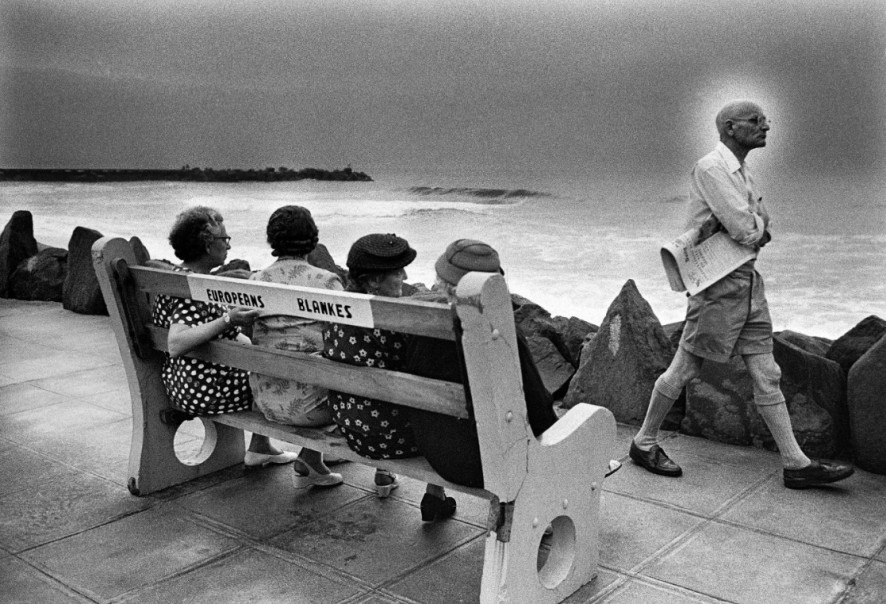Durban, South-Africa, 1959
Silver gelatin print, analogue barite print on Ilford neutral tone paper
Paper 30 x 40 cm
Edition of 20
Exhibitions
2019 Ed van der Elsken, 'Sweet Life', Annet Gelink gallery, AmsterdamLiterature
'Van der Elsken showed his anger about apartheid in the suggestive way he printed this image, and expressed it in the following caption: 'The sea in Durban on the east coast of Africa - the sea in which the black Africans are not allowed to bathe; if a negro feels tired, he can't sit on a bench. That's the way the Christian whites, the chosen few, the members of the superior ladies-and-gentlemen race want it.'
"Beside the sea. In Durban on the east coast of South Africa. Forbidden for black people, if they are too warm they can't cool off in the sea. If they are tired, they can't sit down on the beaches. The Christian blankes , the chosen race, the high-and-mighty pale skins, the Damen-und-Herrenvolk have so decreed." From: Ed van der Elsken, 'Sweet Life', Amsterdam, De Bezige Bij 1966
'On 22 August 1959 Ed van der Elsken and his wife Gerda van der Veen boarded a ship to embark on a trip round the world that would last more than a year. In exchange for free passage, they were to make a film for the Royal Dutch Shipowners Association. They also earned money producing reportages for magazines and travelogues for television. 'Sweet Life', the result of their round-the-world trip, is van der Elsken's masterpiece as a photographer. And while 'Love on the Left Bank' had a dark and pessimistic undertone, in this book he celebrated life. The photographic odyssey embodies van der Elsken's sense of adventure, his entrepreneurial spirit, his inexhaustible fascination with people and other cultures. The name of the book is taken from a boat he photographed in the Philippines; originally the title was to have been 'Crazy World'. The trip took the couple to West Africa, the Malaysian peninsula, the Philippines, Hong Kong, Japan, the United States and Mexico. Their adventure was hazardous at times. In Durban, South Africa, van der Elsken was explicitly warned to stay away from the beer halls because of the recent race riots. Despite this, he wandered as nonchalantly as possible into an enormous beer hall where hundreds of black men sitting at tables with mugs of beer before them peered at him strangely. He eventually took a few photos and even drank a beer with them. Gerda breathed a sigh of relief when van der Elsken re-emerged unscathed.
Van der Elsken designed the picture sequences for 'Sweet Life' himself, spending years working on the publication. Various dummies in which he experimented with format and composition show how the book developed. Frustrated about the delay in publication, he began filming again. Eventually, thanks to his publisher Andreas Landshoff, 'Sweet Life' was printed in Japan and published in seven countries. Van der Elsken stood by the printing presses himself to put it "even more into my totally over-the-top, dramatic, melodramatic style", pushing the copper intaglio technique to its very limits. The large square book is divided into chapters devoted to individual countries, preceded by vivid captions that van der Elsken wrote himself, and printed on an unusual rough paper. The composition is powerful and whimsical: here too he used different ways of cropping pictures and a huge array of different layouts, combining photos on the basis of emotional and formal associations. Van der Elsken's time in Japan would prove crucial to the further development of his career. It was in the big Japanese metropolises that his personal style and confrontational methods assumed their ultimate form. He also made some lifelong friends among the photographers and publishers who worked on various publications and exhibitions.' Ed van der Elsken, 'Camera In Love', Prestel, 2017, p. 157.

